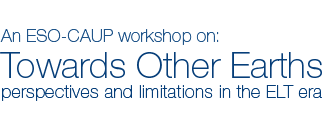 19-23 October 2009, Porto, Portugal
19-23 October 2009, Porto, Portugal
To allow the discovery of other Earths, a new generation of instruments and telescopes is now being conceived and built by different teams around the world. This includes a new generation of Extremely Large Telescopes (ELT). Thanks to the diameter of their primary mirrors, the detection of earth-mass planets is expected to be within the reach of these ELTs.
In parallel, a new generation of instruments for current 8 to 10-m class facilities is being planned. These new cutting-edge suite of instruments include High-angular resolution AO imagers, micro-arcsec astrometry made with interferometers, and ultra stable spectrographs at a cm/s level. Synergies of these facilities with spaced-based observatories will play a key role in the discovery of earth-mass planets.
What are the requirements that this instrumentation have to match to allow us to find other Earths? Do we know how to calibrate the instruments to achieve such a precision and stability? Equally important are the limitations imposed by intrinsic astrophysical phenomena such as stellar activity, granulation, or oscillations. Are we preparing ourselves to deal and to correct for these effects? Which are the ultimate limitations for the different techniques mounted on ground- or space-based facilities?
We therefore want to gather the community of planetary astronomers and instrumentalists working on the field to:
- review what is the current status of the search for telluric exoplanets, and present our understanding about their formation;
- discuss the implications of their main physical properties in the detectability limit by different techniques;
- draw a coherent picture of what are the technical and physical issues that we have to solve in order to endeavor this fabulous task of finding and characterizing other Earths.
Our conference will give particular emphasis to the contribution from the upcoming generation of extremely large telescopes (ELTs) to this task of finding and characterizing other Earths.
Scientific Organizing Committee
- W. Benz (Switzerland)
- J.-L. Beuzit (France)
- D. Charbonneau (USA)
- A. Collier Cameron (UK)
- M. Kissler-Patig (ESO)
- D. Lin (USA)
- C. Melo (ESO, Co-Chair)
- N. C. Santos (Portugal, Co-Chair)
- S. Seager (USA)
- S. Udry (Switzerland)
Local Organizing Committee
N. Santos (Chair), S. Sousa, E. Silva
Organizers
Nuno C. Santos (CAUP), C. Melo, L. Pasquini, A. Glindemann (ESO)


